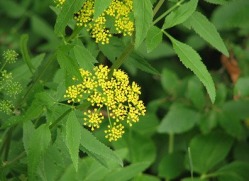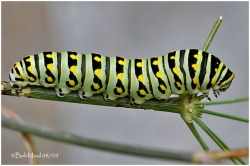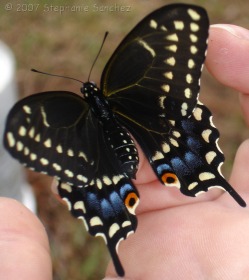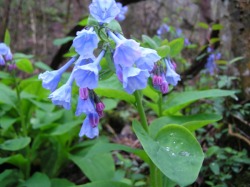Why plant native plants?
Our native plant garden is on the left side of the drive from Pitts Street.
North American native plants, defined as those that existed here without human introduction, are disappearing at an alarming rate due to human activities, such as urban development, agribusiness and the introduction of invasive species. The loss of native plant communities has reduced wildlife habitat and the genetic diversity necessary for balanced ecosystems. New England features both common and rare ecological communities…They are the legacy of millions of years of evolution and geological change, and thousands of years of glacial processes. Many of these plants and animal species dependent upon them are not found anywhere else in the world.
North American native plants, defined as those that existed here without human introduction, are disappearing at an alarming rate due to human activities, such as urban development, agribusiness and the introduction of invasive species. The loss of native plant communities has reduced wildlife habitat and the genetic diversity necessary for balanced ecosystems. New England features both common and rare ecological communities…They are the legacy of millions of years of evolution and geological change, and thousands of years of glacial processes. Many of these plants and animal species dependent upon them are not found anywhere else in the world.
Now Showing in the Native Garden
Woodland Phlox
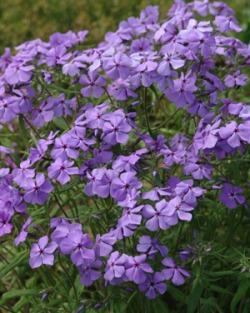
Woodland Phlox/ Wild Sweet William
Phlox divaricata is known by several common names including Woodland Phlox, Wild Blue Phlox, and Wild Sweet William. (Polemoniaceae family)
CULTURE: Phlox divaricata requires little or no maintenance. It prefers moist, humus-rich, well-drained soil and high open shade and accepts sunny conditions with moisture but will go dormant in drought conditions. Powdery mildew can be a serious problem. Cutting back stems after flowering helps combat mildew. Spider mites can also be a problem, particularly in hot, dry conditions.
WILDLIFE: Attracts butterflies and hummingbirds, including swallowtails, gray hairstreaks, and western pygmy blues. Roots consumed by rabbits and voles.
Rabbits like to nibble on Phlox plants (they like the flowers).
DISTRIBUTION: from Maine to South Dakota and Manitoba, south to Georgia, Alabama, Tennessee, Arkansas, and Oklahoma. Zones
Phlox divaricata is known by several common names including Woodland Phlox, Wild Blue Phlox, and Wild Sweet William. (Polemoniaceae family)
CULTURE: Phlox divaricata requires little or no maintenance. It prefers moist, humus-rich, well-drained soil and high open shade and accepts sunny conditions with moisture but will go dormant in drought conditions. Powdery mildew can be a serious problem. Cutting back stems after flowering helps combat mildew. Spider mites can also be a problem, particularly in hot, dry conditions.
WILDLIFE: Attracts butterflies and hummingbirds, including swallowtails, gray hairstreaks, and western pygmy blues. Roots consumed by rabbits and voles.
Rabbits like to nibble on Phlox plants (they like the flowers).
DISTRIBUTION: from Maine to South Dakota and Manitoba, south to Georgia, Alabama, Tennessee, Arkansas, and Oklahoma. Zones
In the native garden, there are two types of columbine. The straight species of Aquilegia canadensis and a hybrid called “Little Lanterns” (a petite form of the plant).Alternate names for the plant are: Wild columbine, wild honeysuckle, meeting-houses, red-bell, Canada columbine, American columbine, rock-lily, jack-in-trousers, cluckies. Ranunculaceae (Crowfoot Family)
CULTURE: Plant Eastern columbine in average, well drained soil in full sun to medium shade. Red columbine is hardy, lives approximately 3 to 5 years, and can readily regenerate by seed. Columbine species are little bothered by powdery mildew or broad mites.
WILDLIFE: Blooms attract hummingbirds, bees, butterflies, and hawk moths. Seeds consumed by finches and buntings. Red columbine is pollinated by hummingbirds, which may depend on the plant as an important nectar source. In addition, at least four bee species have been found to be effective pollinators of red columbine
Aquilegia canadensis is a larval host and/or nectar source for Columbine Duskywing.
DISTRIBUTION: from Nova Scotia to Saskatchewan, south to Florida and Texas.)
CULTURE: Plant Eastern columbine in average, well drained soil in full sun to medium shade. Red columbine is hardy, lives approximately 3 to 5 years, and can readily regenerate by seed. Columbine species are little bothered by powdery mildew or broad mites.
WILDLIFE: Blooms attract hummingbirds, bees, butterflies, and hawk moths. Seeds consumed by finches and buntings. Red columbine is pollinated by hummingbirds, which may depend on the plant as an important nectar source. In addition, at least four bee species have been found to be effective pollinators of red columbine
Aquilegia canadensis is a larval host and/or nectar source for Columbine Duskywing.
DISTRIBUTION: from Nova Scotia to Saskatchewan, south to Florida and Texas.)
Wild Columbine
An important food source for insects and hummingbirds looking for food in the early spring.
An important food source for insects and hummingbirds looking for food in the early spring.
MEDICINAL: Seeds from this plant have been used to treat ailments such as headaches, sore throats, stomatitis, heart problems, skin rash or itch caused by poison ivy, kidney and urinary problems, and fever. They have also been used for ceremonial medicines, perfume, and as additives to tobacco. Roots of this plant can be used to treat gastrointestinal ailments.
Virginia Bluebell, Lungwort
Mertensia virginica or Virginia Bluebell has many different common names, including Virginia Cowslip, Lungwort Oysterleaf, and Roanoke Bells. There are other Mertensia species. in the United States with a similar appearance, but they occur farther north or west and have smaller flowers and pubescent foliage.
CULTURE: They can be found in moist, rich, and loamy soils of upland forests, floodplain forests, wetlands and bluffs. Virginia Bluebells will grow in sun but prefer slight to full shade. Mertensia virginica Virginia Bluebell plants are ephemeral, meaning that they do not bloom for long and go dormant in early summer.
WILDLIFE: The flowers are pollinated by long-tongued bees primarily, including honeybees, bumblebees, Anthophorid bees, Mason bees, large Leaf-Cutting bees, and Miner bees; these insects seek nectar and collect pollen. Other visitors of the flowers include hummingbirds, bee flies, butterflies, skippers, and Sphinx moths, including hummingbird moths. This group of visitors seek nectar from the flowers. Small flower flies may also visit the flowers, however they feed on the pollen and are not effective pollinators.
CULTURE: They can be found in moist, rich, and loamy soils of upland forests, floodplain forests, wetlands and bluffs. Virginia Bluebells will grow in sun but prefer slight to full shade. Mertensia virginica Virginia Bluebell plants are ephemeral, meaning that they do not bloom for long and go dormant in early summer.
WILDLIFE: The flowers are pollinated by long-tongued bees primarily, including honeybees, bumblebees, Anthophorid bees, Mason bees, large Leaf-Cutting bees, and Miner bees; these insects seek nectar and collect pollen. Other visitors of the flowers include hummingbirds, bee flies, butterflies, skippers, and Sphinx moths, including hummingbird moths. This group of visitors seek nectar from the flowers. Small flower flies may also visit the flowers, however they feed on the pollen and are not effective pollinators.
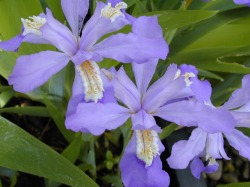
Iris cristata or Dwarf Crested Iris, occurring naturally on rocky wooded slopes and CULTURE: Dwarf Crested Iris only grows 6 to 8 inches tall. Spreads by creeping root-like rhizomes and thrives in shaded rock gardens, preferring well drained soils.
WILDLIFE: The flowers attract hummingbirds and bees.
DISTRIBUTION: from D C. to Indiana and Missouri south to North Carolina, Alabama, Mississippi, Arkansas, and Oklahoma.
WILDLIFE: The flowers attract hummingbirds and bees.
DISTRIBUTION: from D C. to Indiana and Missouri south to North Carolina, Alabama, Mississippi, Arkansas, and Oklahoma.
Spreading Dogbane
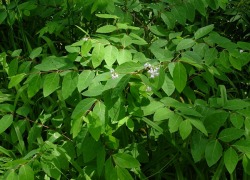
Attracts butterfly and green dandy. Spreads rapidly.
Coral Bells
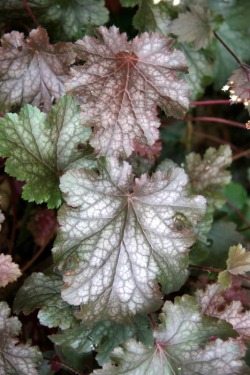
Coral Bells should be divided after 4 years to promote flowering.
Wildlife: attracts hummingbirds
Wildlife: attracts hummingbirds
Blue Eyed Grass
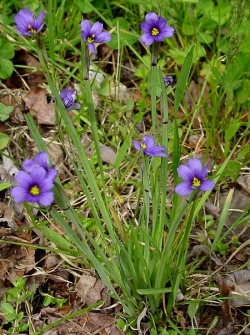
CULTURE: This species likes moist soil and will decline if allowed to dry out. Can handle poor soils and blooms from May – July.
DISTRIBUTION: Native from Maine to Florida and Texas
MEDICINAL: Amerindians used root tea for diarrhea (in children); plant tea for worms, stomachaches. Several species used as laxatives. (Foster & Duke)
DISTRIBUTION: Native from Maine to Florida and Texas
MEDICINAL: Amerindians used root tea for diarrhea (in children); plant tea for worms, stomachaches. Several species used as laxatives. (Foster & Duke)
Foam Flower
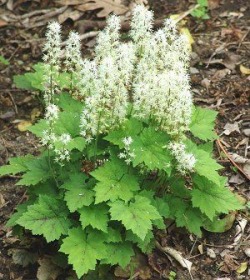
Paragraph.
Bluestar

Bluestar (Amsonia) Apocynaceae (Dogbane Family)is a striking blue native wildflower.
CULTURE: will naturalize. Zones 4 to 9, can be planted/grown in a Bog or pond area, Prairie, Plains, Meadows, Pastures, Savannahs, Marshes
WILDLIFE: attracts butterflies.
CULTURE: will naturalize. Zones 4 to 9, can be planted/grown in a Bog or pond area, Prairie, Plains, Meadows, Pastures, Savannahs, Marshes
WILDLIFE: attracts butterflies.
Sources for Native Plants
These companies have generously donated to the native garden at Johnson Elementary.
New England Wildflower Society
Russell's Garden Shop
Fran's Flowers
River's Edge Nursery
Lowe's
Easywildflowers.com
Other sources for native plants
Mail Order Natives
New England Wildflower Society
Russell's Garden Shop
Fran's Flowers
River's Edge Nursery
Lowe's
Easywildflowers.com
Other sources for native plants
Mail Order Natives
| newfs_conservation_notes_2006.pdf |
Contact and Information on Native Garden
Kathy Roberts
Kathy Roberts
